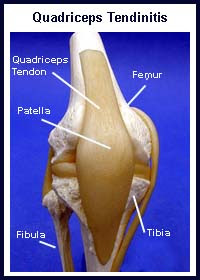The kneecap (patella) is a small bone in the front of the knee. It glides up and down a groove in the thigh bone (femur) as the knee bends and straightens. Tendons connect muscles to bone. The strong quadriceps muscles on the front of the thigh attach to the top of the patella via the quadriceps tendon. This tendon covers the patella and continues down to form the "rope-like" patellar tendon. The patellar tendon in turn, attaches to the shin bone (tibia). The quadriceps muscles, straighten the knee by pulling at the patella via the quadriceps tendon. Quadriceps tendinitis is the term used to describe inflammation of the quadriceps tendon.
Quadriceps tendinitis usually occurs as a result of overdoing an activity and placing too much stress on the quadriceps tendon before it is strong enough to handle the stress. This overuse results in 'micro tears' in the quadriceps tendon which leads to inflammation and pain. Over time damage to the quadriceps tendon can occur. In extreme cases, the quadriceps tendon may become damaged to the point of complete rupture.
Quadriceps tendinitis is common in people involved in activities that include a lot of running, jumping, stopping and starting. Pain from quadriceps tendinitis is felt in the area just above the patella. There may be swelling in and around the quadriceps tendon and it may be sensitive to touch. The pain can be mild or in some cases the pain can be so bad that it prevents athletes from playing their sport.
Examination techniques that detect tenderness and swelling in or around the quadriceps tendon are helpful in determining if someone has quadriceps tendinitis. X-rays are occasionally done to make sure that the quadriceps tendon does not have any calcium in it. Other tests such as diagnostic ultrasound or Magnetic Resonance Imaging (MRI) are sometimes used to rule out more extensive damage to the quadriceps tendon.
Treatment of quadriceps tendinitis may include relative rest, icing, medications to reduce inflammation and pain, stretching and strengthening exercises. Quadriceps tendinitis may be prevented by easing into jumping or running sports and by using good training techniques. Off-season strength training of the legs, particularly the quadriceps muscles, can also help. Doctors and physiotherapists trained in treating this type of overuse injury can outline a treatment plan specific to each individual.

No comments:
Post a Comment